
views
Drinking Whiskey by Itself
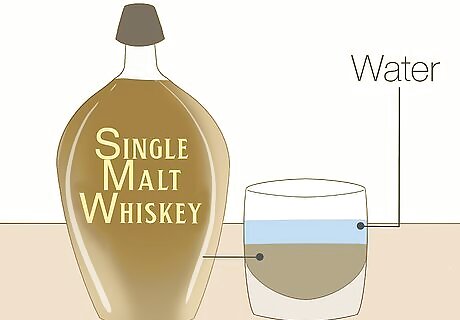
Add a small amount of water to whiskey to enjoy a softer drink. Although this is a matter of some debate, many people choose to pour a little bit of water into their single malt whiskey to dilute it. This makes the drink less sharp and allows them to experience the whiskey’s more subtle flavors. Add a few drops of water to your drink to see if you like it more. Most people who support adding water to whiskey would encourage you to add your water in small increments and to taste; there’s no set amount of water that you should add to your drink. Although some people insist you should only add distilled water to whiskey, others will tell you that tap water works perfectly fine.

Have whiskey on the rocks for a colder, slightly diluted drink. Drinking your whiskey over ice will give you a more chilled and refreshing drink for warmer climates and will slightly numb your palate, making the whiskey a bit more palatable for inexperienced drinkers. The slight dilution of the whiskey caused by the melting ice will also allow you to taste different flavors and nuances in the drink than if you drink it neat. Although connoisseurs of whiskey debate over whether adding ice to the drink is good or bad, some whiskeys, such as high-proof bourbon, are generally considered to be improved by the addition of ice. If you add ice to your whiskey, aim to only use large ice cubes, as these will take longer to melt and will do a better job of keeping your drink cool.
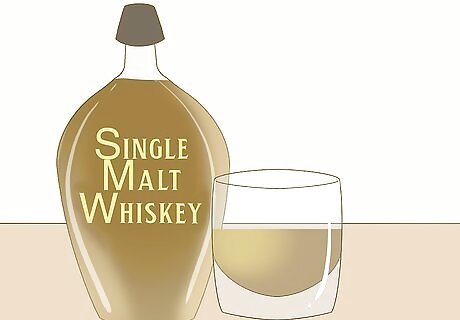
Drink whiskey neat to appreciate the full sensation of its flavor. Drink the whiskey in small sips instead of larger gulps; the high alcohol content may feel overwhelming at first. Once you get used to this effect, however, you’ll be able to appreciate the drink’s flavor and detect the various nuances in your particular whiskey. These nuances in the flavor may include spicy notes, smokiness, woodiness, or hints of other flavors like vanilla and caramel.
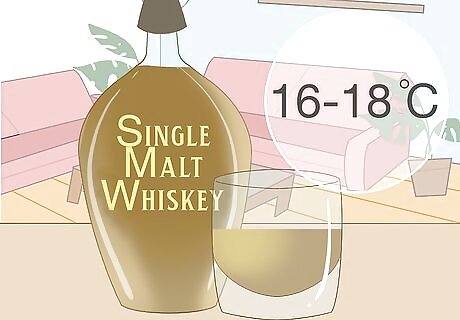
Serve whiskey at room temperature for optimal taste. Whiskey tastes the best when served at temperatures around 60 to 65 °F (16 to 18 °C). Although you or someone you’re serving may choose to add water or ice to the whiskey, thereby changing its temperature, your whiskey should always start out at room temperature before being served. If your whiskey was previously kept in a cool or chilled environment, you can simply leave it out on a kitchen counter or bar until it achieves this optimal temperature.

Nose the whiskey with your mouth open to detect its different flavors. Nosing whiskey is the act smelling your whiskey while it’s in the glass to appreciate its flavor and aroma before drinking it. In contrast to sniffing wine, you should smell the whiskey in small, sharp sniffs and keep your mouth open as you sniff it to avoid overwhelming and “burning” your nose. If sniffing the whiskey starts to become unpleasant, take a break and sniff the back of your hand; this will “reset” your nose and allow you to comfortably smell the whiskey again. The best glass to use for drinking whiskey is a tulip-shaped glass; its unique shape allows you to experience the full aroma of the whiskey.

Store your whiskey at a constant temperature and out of direct sunlight. Changes in light exposure and in temperature cause chemical reactions in your whiskey that can negatively impact its flavor profile. To avoid these, keep whiskey in a part of your house that remains at a constant temperature and that isn’t exposed to direct sunlight, such as your cellar, basement, or an insulated attic. If an opened whiskey bottle is still ⅔ full, you can expect it to remain good to drink for up to a year, if you store it at a constant temperature and away from sunlight. Be sure the bottle is tightly sealed to prevent more air from entering the bottle and interacting with the whiskey. Once a bottle of whiskey becomes more than 75% air, the whiskey will only be good for about another month.
Mixing Whiskey with Other Alcohols

Try a classic Rob Roy cocktail. Combine 3 fluid ounces (89 mL) of Scotch whiskey, 1 fluid ounce (30 mL) sweet vermouth, 2 dashes of bitters, and ice in a mixing glass. Stir the ingredients together, then use a strainer to strain them into a cocktail glass. Finally, twist an orange or lemon peel over the drink and serve. Some Rob Roy recipes call for specifically orange bitters, while some don’t use any bitters at all. If the drink is too strong, you can weaken it without affecting the flavor by reducing the amount of Scotch to 1.5 fluid ounces (44 mL) and the amount of vermouth to 0.5 fluid ounces (15 mL).
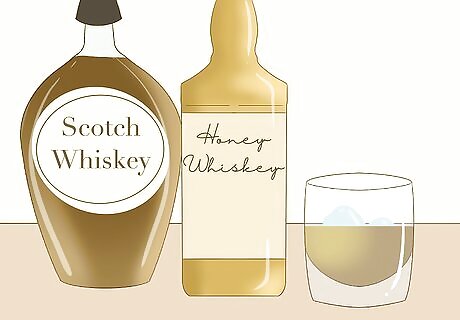
Mix Scotch whiskey and honey whiskey to make a Rusty Nail. Put 2 ice cubes in a rocks glass and place the glass in the freezer to chill. In a separate mixing glass, combine 2 fluid ounces (59 mL) of Scotch, 0.75 fluid ounces (22 mL) of honey whiskey, and ice and stir them together. Then, use a strainer to strain the ingredients into the chilled rocks glass. The amount of honey whiskey used in this recipe is usually equivalent to 1 shot. Recipes for this cocktail typically call for the use of Drambuie as your honey whiskey.
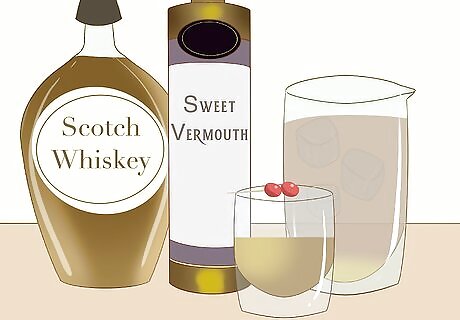
Opt to enjoy a classic Manhattan. Put ice into a mixing glass, then add 0.5 fluid ounces (15 mL) of sweet vermouth and 2 fluid ounces (59 mL) of whiskey. Stir the two together, then use a strainer to strain them into a cocktail glass. This drink can be garnished with a maraschino cherry. You can also add a dash of bitters to the whiskey and vermouth before stirring them together, although this is an optional ingredient.
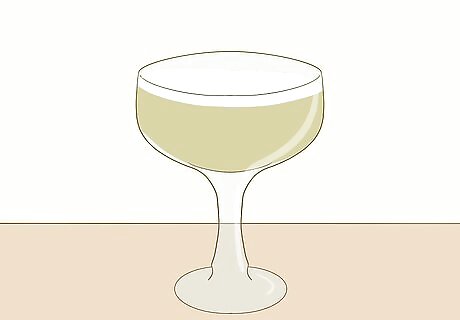
Challenge your mixing skills with an Orkney Chapel. To make this cocktail, pour 2 fluid ounces (59 mL) of whiskey, 0.25 fluid ounces (7.4 mL) of sherry, 0.25 fluid ounces (7.4 mL) of sugar cane syrup, 0.25 fluid ounces (7.4 mL) of orange liqueur, and 0.5 fluid ounces (15 mL) of dry vermouth into a mixing glass. Fill the glass with ice and stir the ingredients together. Finally, use a strainer to strain the drink into a cocktail or coupe glass. You can garnish an Orkney Chapel with an orange peel. This cocktail is known for being slightly difficult to mix, but its final taste is well worth the complexity.

Make a Godfather cocktail out of Scotch and amaretto. Fill a mixing glass just over half of the way with ice, then pour in 2 fluid ounces (59 mL) of whiskey and 0.5 fluid ounces (15 mL) of amaretto. Stir the ingredients together for about 20 seconds, then use a strainer to strain them into a rocks glass with ice. A sweeter version of this drink can be made by using equal portions of whiskey and amaretto.
Combining Whiskey with Other Ingredients

Try a Smoky Haze for a delicious Scottish cocktail. Place 2 chopped rhubarb stalks, a few slices of fresh ginger, and 2 fluid ounces (59 mL) of honey in a pot and bring them to a boil. Reduce the heat and allow this syrup to simmer until the rhubarb breaks down and becomes pulpy. Fill a highball glass ⅔ full with ice, then pour in 1.5 fluid ounces (44 mL) of the syrup, 1 fluid ounce (30 mL) of lemon juice, 2 fluid ounces (59 mL) of whiskey, and a handful of berries, and stir. Top the glass with ginger ale and serve. This cocktail actually originated in Edinburgh, Scotland, making it a true Scottish cocktail.
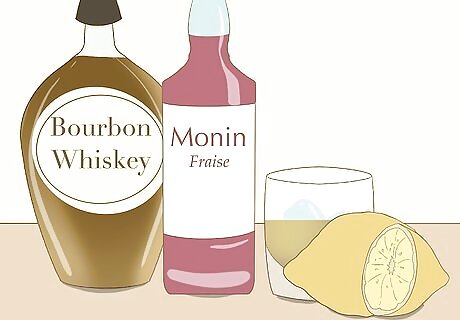
Mix bourbon whiskey, lemon juice, and syrup for a simple cocktail. Fill a shaker with ice, then add 1.5 fluid ounces (44 mL) of bourbon, 0.75 fluid ounces (22 mL) of lemon juice, and 0.75 fluid ounces (22 mL) of simple syrup. Shake the ingredients together, then use a strainer to strain the drink into a rocks glass filled with ice. This recipe makes the classic Whiskey Sour cocktail. The Whiskey Sour can be garnished with a cherry and/or a lemon wedge.

Opt for simplicity with the Scotch and Soda. Fill a highball glass with ice, then pour in 2 fluid ounces (59 mL) of Scotch whiskey. Top the glass with club soda and stir the ingredients together. Consider garnishing this drink with a lemon wedge.

Add cola to whiskey for a Whiskey Cola. Fill a Collins glass with ice and pour in 2 fluid ounces (59 mL) of whiskey. Then, pour in 6 fluid ounces (180 mL) of cola and serve. Many recipes call for Coca-Cola in this cocktail, although you can use any type of cola to make this drink. Every bartender should be familiar with some basic cocktails like cape cod and vodka cranberry. They should get an idea of what is very popular at the job or location where they are working. Then go to a higher level of things like a mudslide using blenders, a French 75, or playing with different flavors.

















Comments
0 comment